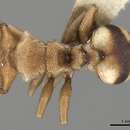en
names in breadcrumbs


This species prefers open, sunny habitats, including the high canopy of rainforest, secondgrowth vegetation, and isolated trees in pastures and around dwellings. It is a relatively common species, and conspicuous due to its color pattern. I most often encounter it on treetrunks and in treefalls. In spite of its commonness, I have only seen nests once. I was collecting in a canopy Ficus, and I found many nests in live branches. The nests were in the very tips of the branches, with inside diameters 5-8mm, outside diameters 15-20mm. The nest chambers were irregular, as though excavated by the ants and not preformed by the plant. Workers were very abundant in the crown of the tree, suggesting a large, polydomous colony with nests in many branches.
Mexico to Brazil and Bolivia. Costa Rica: common in Pacific lowlands, from the Osa Peninsula to Guanacaste Province; rare in the Atlantic lowlands.
Taxonomic history
Klug, 1824 PDF: 211 (q.); Emery, 1890c PDF: 72 (s.); Forel, 1899d PDF: 51 (m.); Wheeler & Wheeler, 1954b PDF: 157 (l.).Combination in Paracryptocerus (Harnedia): Smith, 1949c PDF: 20.Combination in Zacryptocerus: Hespenheide, 1986: 395; De Andrade & Baroni Urbani, 1999 PDF: 368.Senior synonym of Cephalotes elegans: Emery, 1890c PDF: 72; Kempf, 1958a: 142.Senior synonym of Cephalotes flavomaculatus: Emery, 1890c PDF: 72; Kempf, 1958a: 142.Senior synonym of Cephalotes quadriguttatus: Emery, 1890c PDF: 72; Kempf, 1958a: 142.
Cephalotes umbraculatus is a species of arboreal ant of the genus Cephalotes, characterized by an odd shaped head and the ability to "parachute" by steering their fall if they drop off of a tree. They are also known as gliding ants.[1][2]
Cephalotes umbraculatus is a species of arboreal ant of the genus Cephalotes, characterized by an odd shaped head and the ability to "parachute" by steering their fall if they drop off of a tree. They are also known as gliding ants.